A Simple and Reliable Method of Scoring the Thurstone Attitude Scales
Rensis Likert, Sydney Roslow, and Gardner Murphy
In a previous investigation (1) it was found that one of the Thurstone attitude scales (2), when scored by a simpler method than the original Thurstone method (i.e., without the use of a judging group), yielded a higher reliability coefficient than the latter method and still correlated highly with it. In order to determine whether the simpler method of scoring would consistently prove to be satisfactory the present study was undertaken.
In the original study the scale used was the Droba Attitude toward War Scale, Scale No. 2.[1] In the present study the following Thurstone Scales' were used:
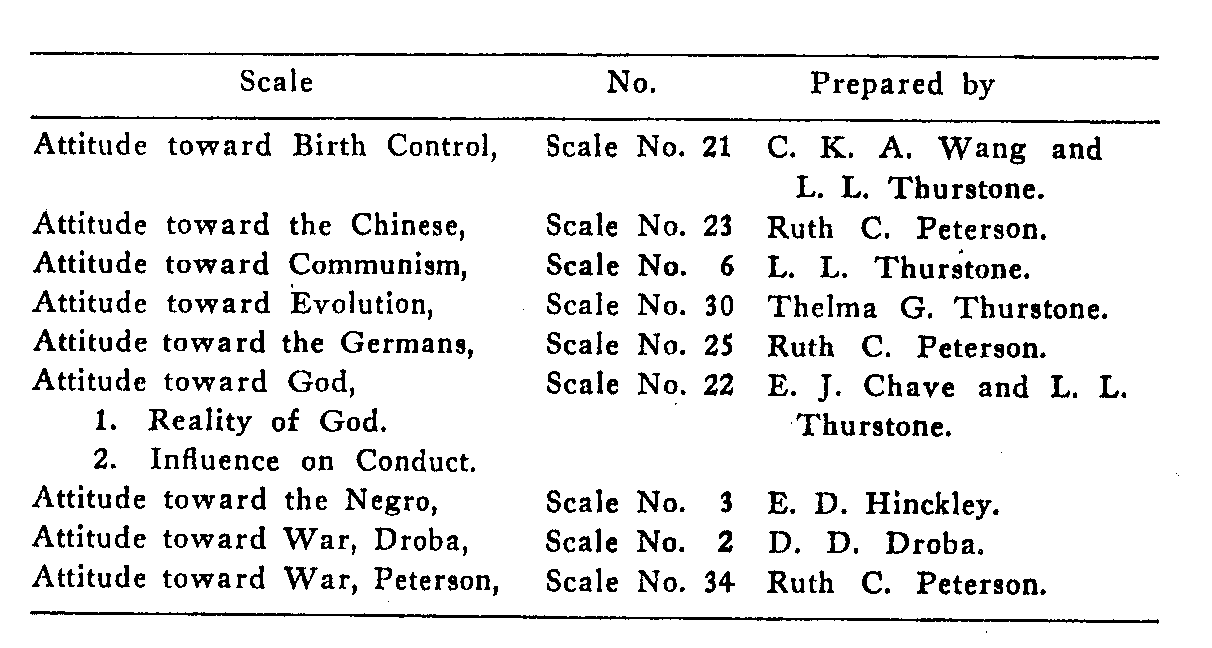
Forms A and B of all scales were used. In the case of the Attitude toward God Scale, Forms A and B of this scale deal with the Reality of God and Forms C and D have to do with Influence on Conduct; all four were used.
All the subjects were men. Groups A, B, C, D, E, and F are students in the University College of Arts and Pure Science of New York University. Groups G and H are students in College of Engineering of the same institution. Groups I, J, K, and L consist of students at the College of the City of New York, and Group M is made up of high-school seniors.
( 229)
The directions at the top of the attitude scales were changed to read as follows:

After the subjects had indicated their reaction to the statements, the scales were scored by the Thurstone method.[2] They were then scored by the simpler method in the following manner: One extreme of the attitude continuum (2), such as "most favorable to the Negro," was designated as the numerically high position and the extreme alternative (strongly agree or strongly disagree) of each statement which corresponded in attitude with that extreme of the attitude continuum was given a value of 5. The other extreme alternative of the given statement was assigned a value of 1. The intermediate alternatives were assigned intermediate values, the interrogation
( 230) point always having, of course, a value of S. Thus, for example, statement number five, Form A, of the Attitude toward the Negro Scale is, "I place the Negro on the same social basis as I would a mule." Obviously to "strongly agree" with this statement reflects an attitude which is "more unfavorable .to the Negro" than "to strongly disagree"; consequently, the "strongly agree" alternative is given a score of 1 and "strongly disagree" is scored 5. This assumes, of course, that we have previously designated the "most favorable to the Negro" extreme of the attitude continuum as the numerically high position. In a similar manner numerical values from 1 to 5 are assigned to each alternative for each statement in the attitude scale.
On each form, however, certain statements could not be used in this scoring method because it was found impossible to determine whether to assign a value of 1 or 5 to the "strongly agree" alternative. An illustration of such a statement is number 5 in Form A of the Droba War Scale: "Compulsory military training in all countries should be reduced but not eliminated." If a subject "agrees" while following the present directions it is impossible to say whether he is agreeing with the "reduction" aspect of this statement or the "not eliminated" aspect. A person who strongly opposes compulsory military training would disagree or strongly disagree with the "not eliminated" aspect whereas a person who favors compulsory military training would probably disagree or strongly disagree with the "reduction" aspect of the statement. Obviously for the present 1-to-5 method of scoring the statement is double-barreled and of little value be-cause it does not differentiate persons in terms of their attitudes. Persons at opposite ends of the attitude continuum may at times check the same alternative.
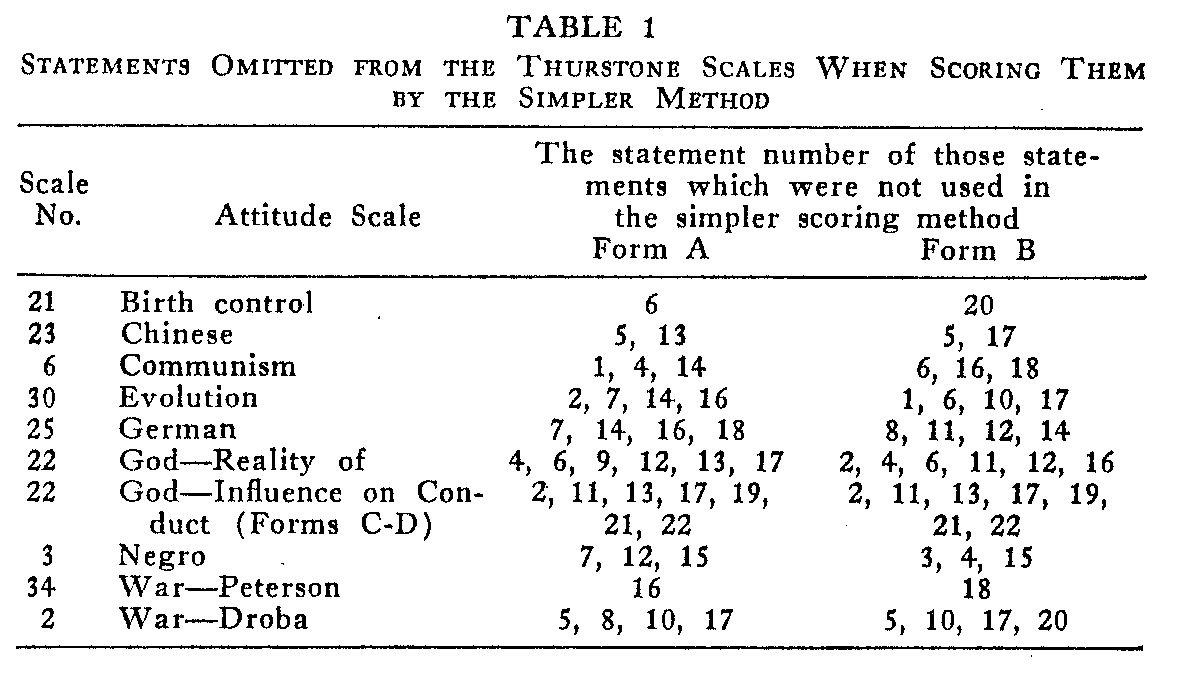
( 231)
In general, those statements whose scale values in the Thurstone method of scoring fell in the middle of the scale (5.0-6.0) were the statements that were found to be unsatisfactory for the simpler method of scoring. Table 1 shows the number of those statements which were net used for each attitude scale.
After assigning a numerical value to each alternative of each statement that was used, the score of every individual was obtained by adding the numbers corresponding to the alternatives that he had checked. In the case of each attitude scale, the same number of statements was used for each form.
The criterion of internal consistency was used to determine whether the numerical values had been assigned to the different alternatives in a consistent manner. Approximately, the highest and lowest 25 per cent of each group were used and their response to each statement tabulated. Then, if the numerical values have been properly assigned to the alternatives for each statement, the sum of the responses for the high group should be higher than the sum for the low group for each statement. The same number of individuals was used, of course, in both high and low groups. In case the sum for the two groups is practically the same for a given statement, it indicates that the statement fails to differentiate the group in the manner done by the other statements and hence is of no value for this particular scale. It is also possible, although it has not occurred in our experience, that the sum for the high group might be appreciably smaller than the sum for the low group for a given statement. If this should occur, it would indicate that we have assigned numerical values to the alternatives in the reverse order of what they should be; i.e., what we have designated 5 should be 1, etc.
The reliability coefficients were calculated for the different attitude scales for both methods of scoring and the coefficients of correlation between the two methods of scoring were computed. The results are shown in Table 2. The obtained reliability coefficient shows the value of the correlation coefficient between Forms A and B of each scale. The predicted reliability coefficient shows the expected reliability based on the Spearman-Brown formula for the combined scores of the two forms.
An examination of Table 2 shows that the results of this study are similar to the results obtained in the early investigation (1). When the reliability coefficients for the two methods of scoring are equated for the number of items used, the simpler method is found to yield higher re-liability coefficients than the Thurstone method for all ten attitude scales and for every group used. In many instances the reliability obtained by the simpler method of scoring is considerably higher than that obtained by the Thurstone method.
( 232)
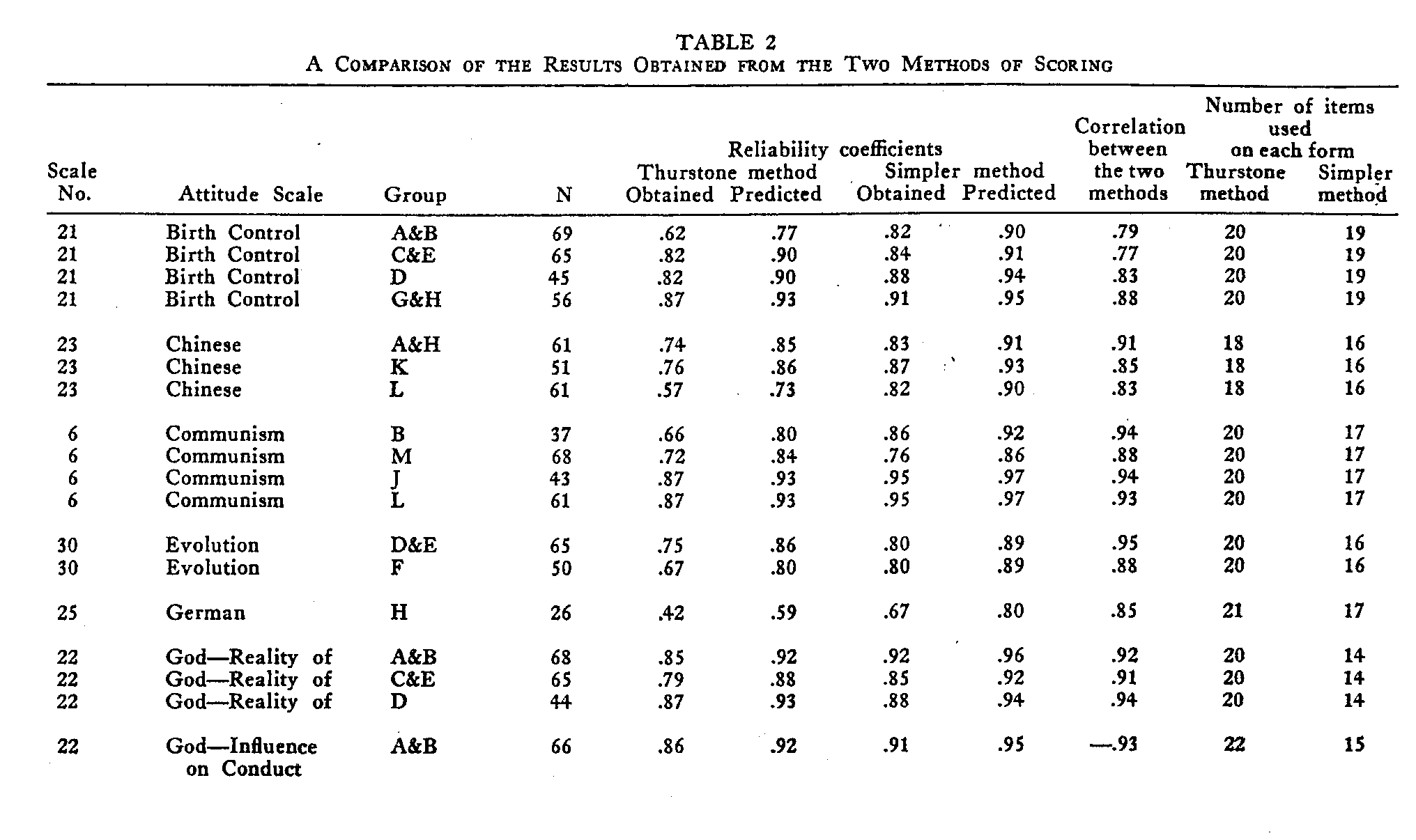
( 233)
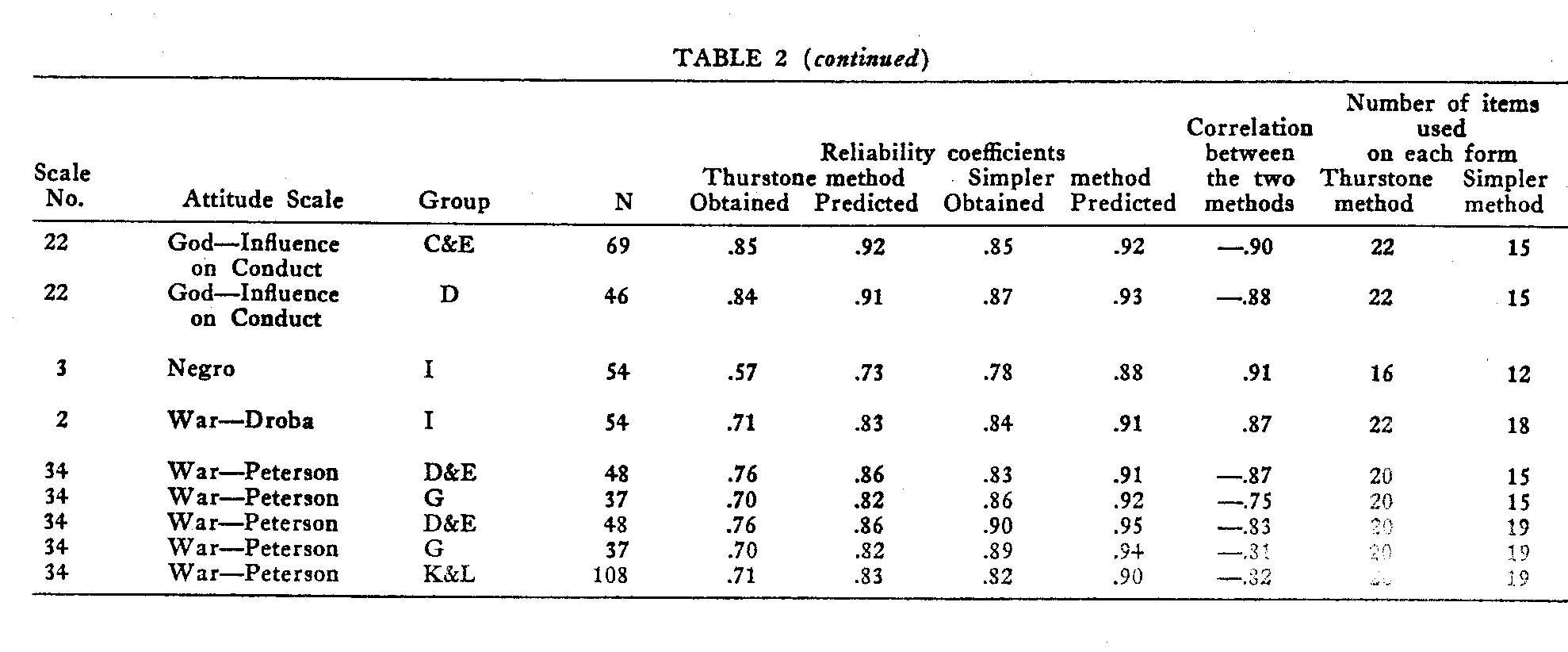
( 234)
Likewise, the correlation between the two methods of scoring is found to be consistently high, which indicates that the simpler method of scoring is measuring essentially what is measured by the Thurstone scoring method.[3] The negative coefficients of correlation between the two methods of scoring in the case of the Attitude toward War Scale of Peterson and the Influence on Conduct part of the Attitude toward God Scale are due to a reversal in the scores assigned by the Thurstone method to the various parts of the attitude continuum. On all the other scales the numerically larger score in the Thurstone method is assigned to the more "favorable" extreme of the attitude continuum. For convenience it is assumed that most social attitudes are "favorable" or "unfavorable" toward some defined idea, act, or group of persons, and high scores are arbitrarily assigned to the "favorable" end. This procedure has been consistently adhered to in the scoring by the simpler method.
The method by which Thurstone scores most of his attitude scales is to use the median of the scale values of the statements with which an individual agrees. Recently some of the scales are being scored by using the median of the scale values of the statements with which a person strongly agrees. All the results shown in Table 2 are obtained by scoring the scales by the former method. Of the scales used in this study those that Thurstone scores by the latter or "strongly agree" method include the Attitude toward Birth Control Scale and both parts of the Attitude toward God Scale. Consequently, it seemed desirable to compare the Thurstone "strongly agree" method of scoring these scales with the simpler method. This comparison along with the results obtained when these scales are scored by the more common Thurstone "agree" method are shown in Table 3. The data for the Thurstone "agree" method and the simpler method are the same as shown in Table 2, but are reproduced to facilitate comparison.
An examination of Table 3 reveals that, although the directions accompanying these scales call for the use of the Thurstone "strongly agree" method in their scoring, this method is the least satisfactory of all. It proves to be unsatisfactory for two reasons. First, a large number of individuals fail to indicate that they strongly agree with any statement. The discrepancy in the number of cases between the "strongly agree"and the "agree" method shows the number of individuals in each group who failed to indicate that they strongly agreed with any statement on one or both forms of a scale. Obviously, then, this method cannot be used for obtaining scores on all the individuals in most groups. To use the "agree" method along with the "strongly agree" method in order to obtain scores
( 235)
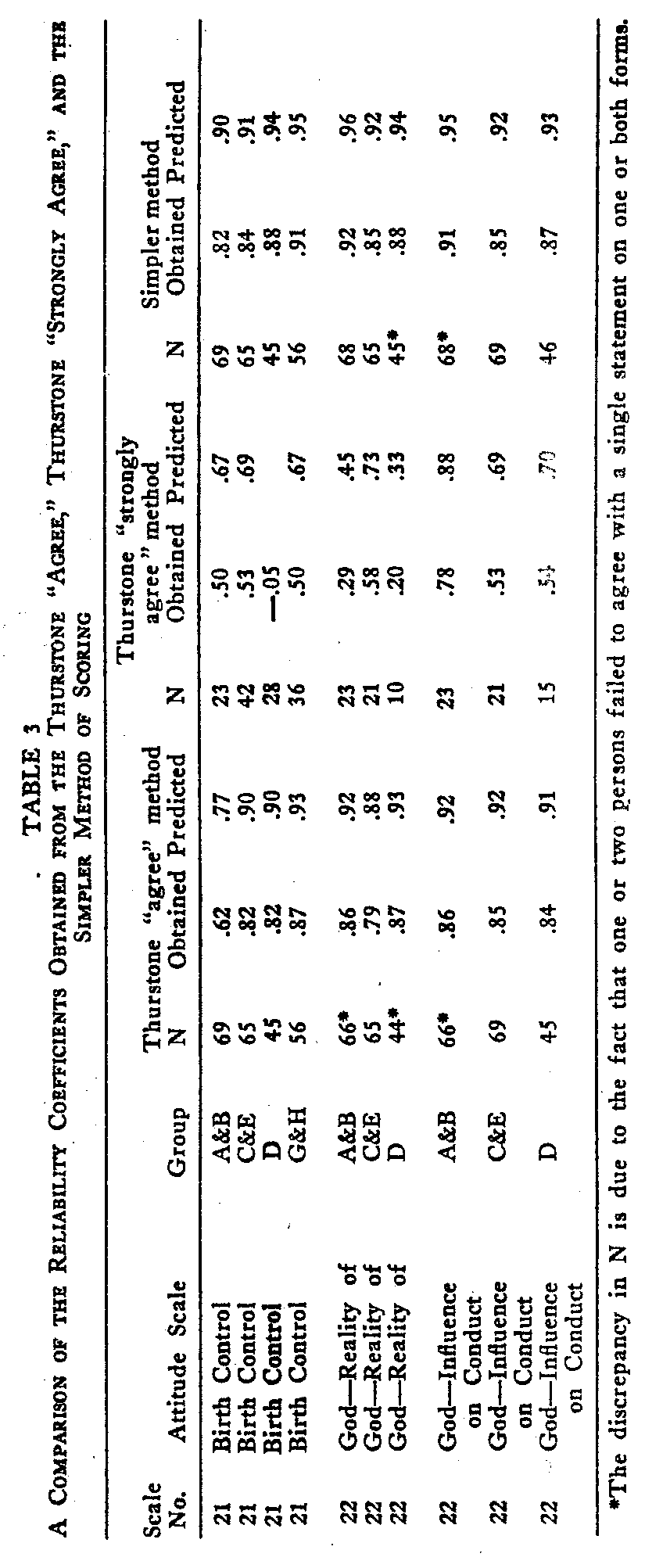
( 236)
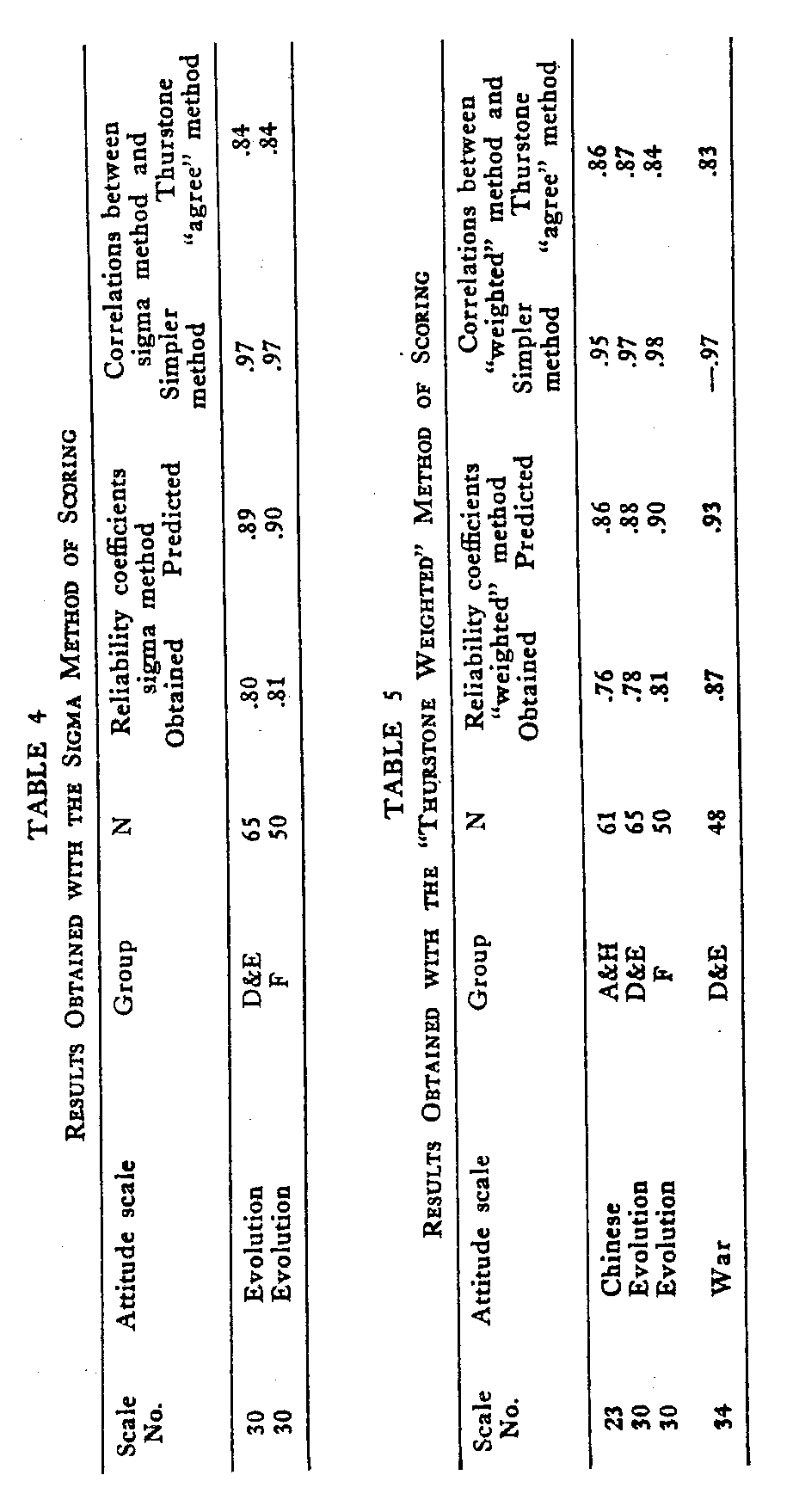
( 237) for all the individuals has evident objections. In the second place, the "strongly agree" method is unsatisfactory because of the low reliability that it yields. Only one of the correlations between the two forms of a scale (the obtained r, Table 3) is higher than .70, many of the rest clustering about .53 and some even below .30.
The sigma method which has been fully described elsewhere (1, pp. 21-25) was tried and yielded the expected results which are shown in Table 4. Although much more elaborate than the simpler method the results obtained from the two methods are essentially the same.
Another method which is in a way a combination of the Thurstone and simpler methods was also tried. The results from this method, called the "Thurstone weighted method," are shown in Table 5. The same statements were used in this scoring as were used in the simpler method, but instead of assigning 1-2-3-4-5 to the respective alternatives, the values assigned were based upon the scale values of the Thurstone method. The "strongly agree" alternative of each statement was given the value shown by the Thurstone key for that statement. The "strongly disagree" alternative of each statement was given a value equal to 11.0 minus the value of the "strongly agree" alternative for that particular statement. The question mark was always given the value of 5.5 and the "agree" alternative for each statement was given a value midway between 5.5 and the value of the "strongly agree" alternative for the same statement. The "disagree" position was similarly scored. Thus, for example, statement number one of Form A of the Attitude toward the Chinese has a Thurstone scale value of 7.8; consequently, the "strongly agree" position for this statement receives a score of 7.8. The score of the "strongly disagree" alternative is 11.0 minus 7.8 or 3.2. The "agree" position has a scale value midway between 7.8 and 5.5 (the value of the question-mark position) or 6.65; similarly the "disagree" position has a value of 4.35.
An examination of the data in Table 5 reveals that the "Thurstone weighted method" yields essentially the same results as the simpler method and correlates very highly with it. It is evident therefore that the additional effort required to weight the alternative values is unwarranted, since the simpler method yields results as satisfactory as that obtained from either the sigma method or the "weighted" method.
SUMMARY
A simple method of scoring the Thurstone Attitude Scales is discussed, which does not involve the use of a judging group and yet is found to be consistently more reliable than the original method of scoring. The scores obtained by the two methods correlate highly, indicating that they are measuring essentially the same thing.
( 238)
REFERENCES
1. LIKERT, R. A technique for the measurement of attitudes. Arch. Psychol., 1932, No. 140. Pp. 52.
2. THURSTONE, L. L., & CHAVE, E. J. The measurement of attitude. Chicago: Univ. Chicago Press, 1929. Pp. 96.
New York University and Columbia University
New York City